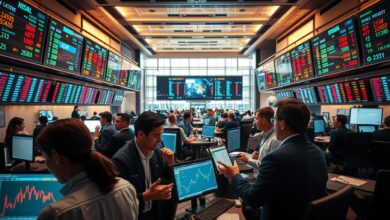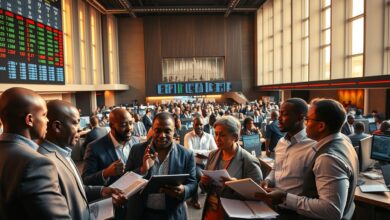Art as an Investment: Pros and Cons of Investing in Fine Art
Investing in fine art is becoming more popular among those looking to diversify their portfolios. This trend is fueled by art’s unique blend of beauty and financial potential. Yet, diving into the art market comes with its own set of challenges and benefits.
In South Africa, the art scene offers unique opportunities. Understanding the basics of art investment is crucial. It helps investors make smart choices in the ever-changing economic landscape.
Understanding the Concept of Art as an Investment
Art has long been seen as a way to diversify investments. It attracts both individuals and institutions. The art investment definition covers a wide range of artworks, from traditional paintings to digital formats.
Investors look for artworks that they find beautiful and have the chance to increase in value.
Definition of Art Investment
The art investment definition is about buying artworks hoping their value will go up. This depends on the artist’s fame, the artwork’s history, and how much people want it. Each piece has its own story, making it appealing and valuable.
Historical Perspective on Art Investment
Art investment has gone through big changes over time. Famous artworks have sold for millions at auctions. The rise of global art fairs has made it easier for people to buy and sell art.
This has made art a key part of the investment world.
Modern Trends in Art Investment
Today’s art market is changing fast, thanks to technology and cultural shifts. Digital art and NFTs are opening up new investment opportunities. These new forms of art are attracting modern collectors.
South Africa’s art scene is starting to explore these new trends, showing growing interest in modern art investment.
The Financial Benefits of Investing in Art
Investing in art can bring many financial benefits. It’s appealing to both seasoned investors and newcomers. Artwork often increases in value over time, offering high returns. With the right strategy, investors can make significant gains and enjoy their collections.
Potential for High Returns
Art has shown strong potential for high returns. Rare pieces and works by famous artists often see big increases in value. Auction results often show artworks selling for much more than before. Choosing the right pieces wisely can lead to impressive financial gains.
Diversification of Portfolio
Art is great for diversifying a portfolio. It doesn’t move in the same way as traditional markets, making it a good hedge. A well-planned art portfolio can balance out other investments, reducing risk. This approach can help stabilize returns during tough times.
Tax Advantages in South Africa
In South Africa, art investors can enjoy tax benefits. These include exemptions or lower capital gains tax for certain art deals. Knowing these tax perks can help investors make better choices, growing their wealth while following the law.
Risks Involved in Art Investment
Investing in art offers many chances but also comes with big risks. It’s key to know these risks before diving in. Many things can change an art piece’s value, making it hard for investors to predict. This part talks about the main risks, like market ups and downs, fake art, and changing art values.
Market Volatility and Illiquidity
Art markets can be very unpredictable. Prices and demand can swing due to the economy or new trends. Selling art can be tough, making it hard to turn it into cash. This can be especially risky during bad economic times when there are fewer buyers.
Authenticity and Provenance Risks
Checking if art is real is very important. Fake art can greatly lower a piece’s value. It’s crucial to research and verify a piece’s history to avoid big losses. This step helps protect against fake art.
Changing Trends in Art Valuation
Art values can change due to new trends and tastes. Investors need to keep up with these changes. New artists and styles can quickly shift market preferences. Staying current helps make better choices and can lead to better results.
Building a Fine Art Collection
Starting a fine art collection is an exciting journey. It’s for both new enthusiasts and seasoned investors. To do well, you need to set a budget, find what you like, and do your research.
Tips for First-Time Art Investors
First-time art investors should first define their budget. Knowing your spending limit helps you make smart choices. Finding what you like helps narrow down your search to specific styles or periods.
Exploring different art galleries and online platforms is also key. It gives you a wide range of options to consider.
Importance of Research and Due Diligence
Researching art investments is crucial for a successful collection. It’s important to know about the artists you’re interested in. This helps you understand their value and market potential.
Staying up-to-date with market trends is also essential. This way, you can make informed decisions. Don’t buy art without fully understanding its worth and significance.
Engaging with Galleries and Artists
Talking to art galleries can open doors to valuable resources and insights. They often host exhibitions and workshops that showcase new artists. This can help you find unique pieces.
Talking directly to artists can also lead to special opportunities. You might get to see exclusive works or have private viewings. This makes your collection more personal and valuable.
The Role of Art Advisors and Dealers
Investing in art is complex, with many factors to consider. Art advisors and dealers are key players. They help collectors make smart choices, guiding them through the art market. Their expertise can greatly impact the success of art investments.
What an Art Advisor Can Offer
Art advisors offer many services that are very helpful. They help clients:
- Evaluate artwork for investment potential
- Understand market trends
- Find emerging artists and valuable pieces
- Negotiate prices and terms
With their knowledge, art advisors help investors make better choices. This can increase the value of a collection over time.
How to Choose the Right Dealer
Choosing the right art dealer is important. Consider these factors:
- The dealer’s reputation and trustworthiness
- What types of art they specialize in
- Success in making big deals
- Clear fees and commissions
Researching well can lead to good relationships with reliable dealers. This is key for success in art investments.
The Cost of Professional Guidance
Getting professional art advice comes with costs. These can vary based on the services. Advisors might charge a percentage of the sale or a flat fee.
While these costs may seem high, they often pay off. A good advisor or dealer can find opportunities that bring strong returns. Their expertise is a valuable asset for any art investor.
Evaluating Artwork for Investment
When looking to invest in artwork, several key points must be considered. It’s not just about the art’s beauty but also the market’s role in pricing and demand. Knowing these factors helps match art with investment goals.
Criteria for Selecting Art Pieces
Choosing the right art for investment starts with understanding important criteria. Key factors include:
- Artist Reputation: Famous artists usually get higher prices than new or lesser-known ones.
- Historical Pricing: Looking at past auction results can show trends in demand and value.
- Aesthetic Appeal: Your personal taste in a piece can affect its future value.
Understanding Art Market Trends
Knowing the art market is crucial for spotting valuable trends. Grasping market movements, genres, and cycles helps predict changes. Art fairs, exhibitions, and online sites are key in shaping these trends.
Importance of Condition Reports
Art condition reports are essential for detailing artwork’s physical state. They help in evaluating and can greatly impact resale value. A detailed report can reassure buyers about the piece’s condition, reducing worries about restoration or damage.
The Impact of Economic Conditions
Economic conditions greatly affect art values. They influence buying behaviors and market dynamics. Factors like consumer confidence, inflation, and employment levels can change the art market during recessions.
Investors should understand how economic conditions impact art values. This is especially true during downturns.
How Economic Factors Affect Art Values
When the economy grows, art values often rise. This is because people spend more, and wealthy individuals buy art as an investment. But, during economic downturns, the market softens, and prices drop.
Collectors and investors may buy less, leading to lower demand. This shows how economic conditions affect art values.
Art Market Responses to Economic Downturns
In recessions, the art market turns to more affordable works. Collectors might choose emerging artists or lower-priced pieces. This is a way to protect their investments.
Investors might also diversify their portfolios to reduce risks. Being adaptable can help keep value in tough times.
Legal Considerations in Art Investment
Getting into art investment means understanding the legal side. You need to know about copyright, making clear contracts, and following art import-export rules. Knowing these can help avoid problems and keep your investment safe.
Understanding Copyright and Ownership
Copyright is about the rights artists have and how they affect buyers. Many think buying art means they can use it however they want. But, artists usually keep their copyright unless they give it up. This shows why it’s key for investors to know about art investment laws to avoid mistakes.
Contracts and Agreements with Artists
Having solid art contracts is crucial for both artists and investors. These should cover the sale terms, copyright, and any commissions. Good contracts clear up any confusion and ensure fair deals. They protect the interests of all involved in a sale.
Import and Export Regulations for Art
Buying or selling art across borders brings up special rules. Each country has its own laws for moving art, like taxes and tariffs. Investors must learn these rules to follow them. Ignoring them can cause big problems, so it’s smart to do your homework or get legal advice.
Conclusion: Weighing the Pros and Cons of Art Investment
Investing in fine art is a mix of chances and hurdles. It offers big returns, adds variety to a portfolio, and brings joy through beauty. Yet, it comes with risks like market ups and downs, questions about authenticity, and changes in value. Knowing these points is key for those wanting to dive into this exciting field.
For those thinking about investing, it’s important to do your homework. Working with trusted art advisors and galleries can help understand the art world better. Staying updated on market trends and cultural shifts helps investors make smart choices.
In short, the art investment world is complex and varied. By carefully considering both sides, people can invest in art confidently. This way, they can make choices that are both meaningful and financially wise.
FAQ
What is art as an investment?
What are the benefits of investing in fine art?
What risks are associated with art investment?
How can one start building a fine art collection?
What role do art advisors and dealers play in the investment process?
What criteria should be considered when evaluating artwork for investment?
How do economic conditions impact art investment values?
What legal considerations should investors be aware of in art transactions?
Published on: 1 de April de 2025

Bakari Romano
Bakari Romano is a finance and investment expert with a strong background in administration. As a dedicated professional, Bakari is passionate about sharing his knowledge to empower individuals in managing their finances effectively. Driven by this mission, he founded FinancasPro.com, where he provides insightful and practical advice to help people make informed financial decisions. Through his work on the site, Bakari continues to make finance accessible and understandable, bridging the gap between expert knowledge and everyday financial needs.






